Dual Toroidal Dipole Resonance Metamaterials under a Terahertz Domain
Abstract
1. Introduction
2. Sample Design and Characterization
3. Results and Discussion
4. Conclusions
Author Contributions
Funding
Conflicts of Interest
Appendix A
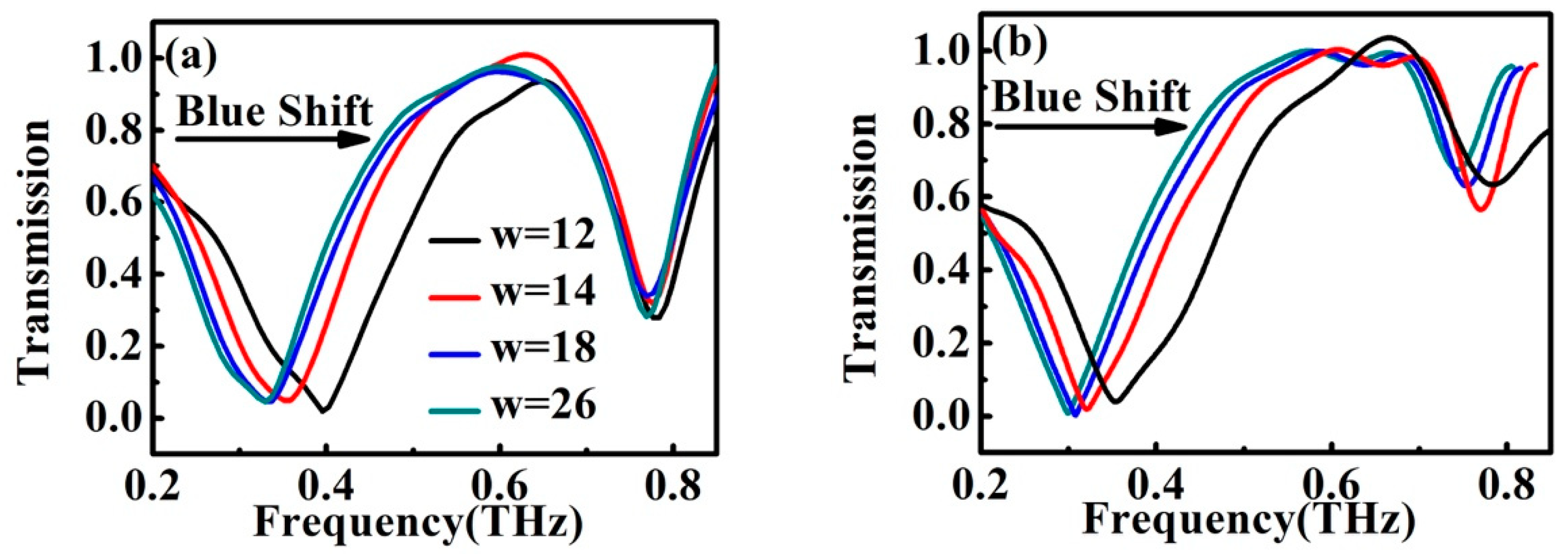
Appendix B
- Electric dipole:
- Magnetic dipole:
- Electric circular dipole:
- Toroidal dipole:
References
- Afanasiev, G.N.; Stepanovsky, Y.P. The electromagnetic field of elementary time-dependent toroidal sources. Phys. A Math. Gen. 1995, 28, 4565–4580. [Google Scholar] [CrossRef]
- Boardman, A.D.; Marinov, K.; Zheludev, N.; Fedotov, V.A. Dispersion properties of nonradiating configurations: Finite-difference time-domain modeling. Phys. Rev. E 2005, 72, 036603–036606. [Google Scholar] [CrossRef] [PubMed]
- Afanasiev, G.N.; Dubovik, V.M. Some remarkable charge–current configurations. Phys. Part. Nuclei 1998, 29, 366–391. [Google Scholar] [CrossRef]
- Sawada, K.; Nagaosa, N. Optical magnetoelectric effect in multiferroic materials: Evidence for a Lorentz force acting on a ray of light. Phys. Rev. Lett. 2005, 95, 237402. [Google Scholar] [CrossRef] [PubMed]
- Papasimakis, N.; Fedotov, V.A.; Marinov, K.; Zheludev, N.I. Gyrotropy of a metamolecule: Wire on a torus. Phys. Rev. Lett. 2009, 103, 093901. [Google Scholar] [CrossRef] [PubMed]
- Fedotov, V.A.; Marinov, K.; Boardman, A.D.; Zheludev, N.I. On the aromagnetism and anapole moment of anthracene nanocrystals. New J. Phys. 2007, 9, 1–10. [Google Scholar] [CrossRef]
- Ceulemans, A.; Chibotaru, L.F.; Fowler, P.W. Molecular Anapole Moments. Phys. Rev. Lett. 1998, 80, 1861–1864. [Google Scholar] [CrossRef]
- Dubovik, V.M.; Tugushev, V.V. Toroid moments in electrodynamics and solid-state physics. Phys. Rep. 1990, 187, 145–202. [Google Scholar] [CrossRef]
- Marinov, K.; Boatdman, A.; Fedotov, V.; Zheludev, N. Toroidal metamaterial. New J. Phys. 2007, 9, 324. [Google Scholar] [CrossRef]
- Kaelberer, T.; Fedotov, V.A.; Papasimakis, N.; Tsai, D.P.; Zheludev, N.I. Toroidal Dipolar Response in a Metamaterial. Science 2010, 330, 1510–1512. [Google Scholar] [CrossRef] [PubMed]
- Dong, Z.G.; Zhu, J.; Rho, J. Optical toroidal dipolar response by an asymmetric double-bar metamaterial. Appl. Phys. Lett. 2012, 101, 145. [Google Scholar] [CrossRef]
- Gupta, M.; Singh, R. Toroidal versus Fano Resonances in High Q planar THz Metamaterials. Adv. Opt. Mater. 2016, 4. [Google Scholar] [CrossRef]
- Cojocari, M.V.; Schegoleva, K.I.; Basharin, A.A. Blueshift and phase tunability in planar THz metamaterials: The role of losses and toroidal dipole contribution. Opt. Lett. 2017, 42, 1700. [Google Scholar] [CrossRef] [PubMed]
- Ding, C.; Jiang, L.; Sun, C.; Wu, L.; Xu, D.; Zhang, G. Stable terahertz toroidal dipolar resonance in a planar metamaterial. Phys. Status Solidi 2015, 252, 1388–1393. [Google Scholar] [CrossRef]
- Gupta, M.; Savinov, V.; Xu, N.; Cong, L.; Dayal, G.; Wang, S. Sharp Toroidal Resonances in Planar Terahertz Metasurfaces. Adv. Mater. 2016, 28, 8206–8211. [Google Scholar] [CrossRef] [PubMed]
- Basharin, A.A.; Kafesaki, M.; Economou, E.N. Dielectric Metamaterials with Toroidal Dipolar Response. Phys. Rev. X 2014, 5, 1–11. [Google Scholar] [CrossRef]
- Papasimakis, N.; Fedotov, V.A.; Savinov, V. Electromagnetic toroidal excitations in matter and free space. Nat. Mater. 2016, 15, 263. [Google Scholar] [CrossRef] [PubMed]
- Raybould, T.; Fedotov, V.; Papasimakis, N. Focused electromagnetic doughnut pulses and their interaction with interfaces and nanostructures. Opt. Express 2016, 24, 3150–3161. [Google Scholar] [CrossRef] [PubMed]
- De Chatel, P.F.; Buin, A.K. Toroid dipole moments and hybridization in uranium compounds. Phys. B 2002, 319, 193–198. [Google Scholar] [CrossRef]
- Watson, D.W.; Jenkins, S.D.; Ruostekoski, J. Toroidal dipole excitations in metamolecules formed by interacting plasmonic nanorods. Phys. Rev. B 2016, 22, 15088–15096. [Google Scholar] [CrossRef]
- Marti, G.E.; Olf, R.; Dan, S.K. Collective Excitation Interferometry with a Toroidal Bose-Einstein Condensate. Phys. Rev. A 2015, 91, 227–228. [Google Scholar] [CrossRef]
- Liu, W.; Zhang, J.; Miroshnichenko, A.E. Toroidal dipole-induced transparency in core–shell nanoparticles. Laser Photonics Rev. 2015, 9, 564–570. [Google Scholar] [CrossRef]
- Terekhov, P.D.; Baryshnikova, K.V.; Shalin, A.S. Nonradiating anapole modes of dielectric particles in terahertz range. In Proceedings of the Days on Diffraction, St. Petersburg, Russia, 27 June–1 July 2016; IEEE: Piscataway, NJ, USA, 2016. [Google Scholar]
- Huang, Y.W.; Chen, W.T.; Wu, P.C. Design of plasmonic toroidal metamaterials at optical frequencies. Opt. Express 2012, 20, 1760–1768. [Google Scholar] [CrossRef] [PubMed]
- Li, C.; Liu, H.; Cao, J.X. Structural-configurated magnetic plasmon bands in connected ring chains. Opt. Express 2009, 17, 11486–11494. [Google Scholar] [CrossRef] [PubMed]
- Liu, N.; Liu, H.; Zhu, S.N. Stereometamaterials. Nat. Photonics 2009, 3, 157–162. [Google Scholar] [CrossRef]
- Li, J.; Dong, Z.D.; Zhu, M.J. Dual-band toroidal-dipole-induced transparency in optical regime. Phys. D Appl. Phys. 2016, 49, 345104. [Google Scholar] [CrossRef]
- Basharin, A.A.; Chuguevsky, V.; Volsky, N. Extremely high Q-factor metamaterials due to anapole excitation. Phys. Rev. B 2017, 95. [Google Scholar] [CrossRef]
- Ungur, L.; Langley, S.K.; Hooper, T.N. Net toroidal magnetic moment in the ground state of a {Dy6}-triethanolamine ring. Am. Chem. Soc. 2012, 134, 18554–18557. [Google Scholar] [CrossRef] [PubMed]
- Chen, C.J.; Hsiao, C.T.; Tsai, D.P. Optical magnetic response in three-dimensional metamaterial of upright plasmonic meta-molecules. Opt. Express 2011, 19, 12837–12842. [Google Scholar] [CrossRef] [PubMed]
- Vretenar, D.; Paar, N.; Ring, P. Toroidal dipole resonances in the relativistic random phase approximation. Phys. Rev. C 2001, 65, 021301. [Google Scholar] [CrossRef]
- Savinov, V.; Fedotov, V.A.; Chen, W.T. Toroidal photonic metamaterial. In Proceedings of the Conference on Lasers and Electro-Optics, San Jose, CA, USA, 6–11 May 2012; IEEE: Piscataway, NJ, USA, 2012. [Google Scholar]
- Fattinger, C.; Grischkowsky, D.; Exter, M.V. Far-infrared time-domain spectroscopy with terahertz beams of dielectrics and semiconductors. Opt. Soc. Am. B 1990, 7, 2006–2015. [Google Scholar] [CrossRef]
- Azad, A.K.; Dai, J.; Zhang, W. Transmission properties of terahertz pulses through subwavelength double split-ring resonators. Opt. Lett. 2006, 31, 634–636. [Google Scholar] [CrossRef] [PubMed]
- Ordal, M.A.; Long, L.L.; Bell, R.J. Optical properties of the metals Al, Co, Cu, Au, Fe, Pb, Ni, Pd, Pt, Ag, Ti, and W in the infrared and far infrared. Appl. Opt. 1983, 22, 1099–1119. [Google Scholar] [CrossRef] [PubMed]
- Ree, M.; Chen, K.-J.; Kirby, D.P. Anisotropic properties of high-temperature polyimide thin films: Dielectric and thermal-expansion behaviors. Appl. Phys. 1992, 72, 2014–2021. [Google Scholar] [CrossRef]
- Singh, R.; Alnaib, I.A.I.; Yang, Y. Observing metamaterial induced transparency in individual Fano resonators with broken symmetry. Appl. Phys. Lett. 2011, 99, 201107. [Google Scholar] [CrossRef]
- Taylor, A.J.; Alnaib, I.A.I.; He, M. Low-loss ultra-high-Q dark mode plasmonic Fano metamaterials. Opt. Lett. 2012, 37, 3366–3368. [Google Scholar] [CrossRef]
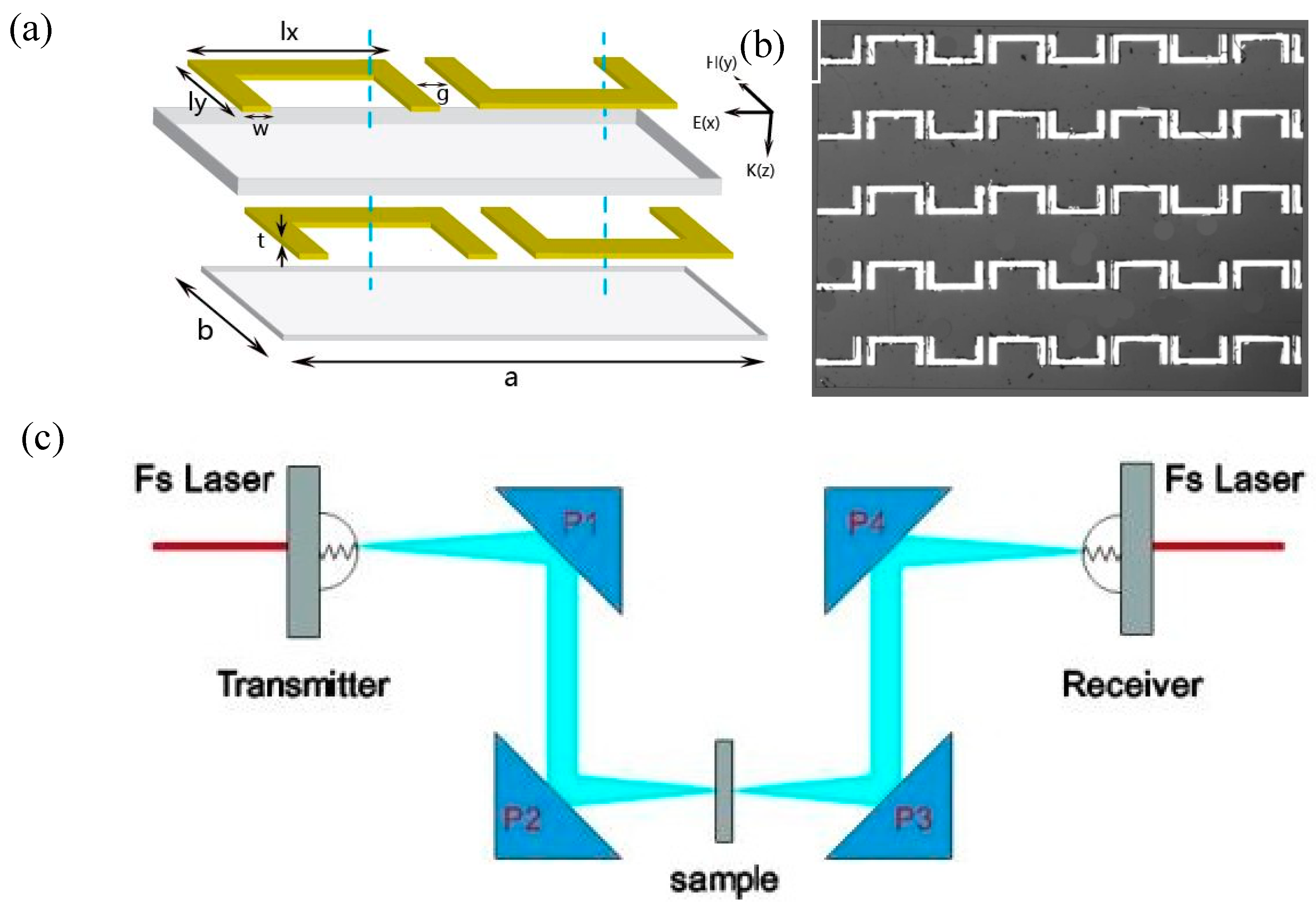
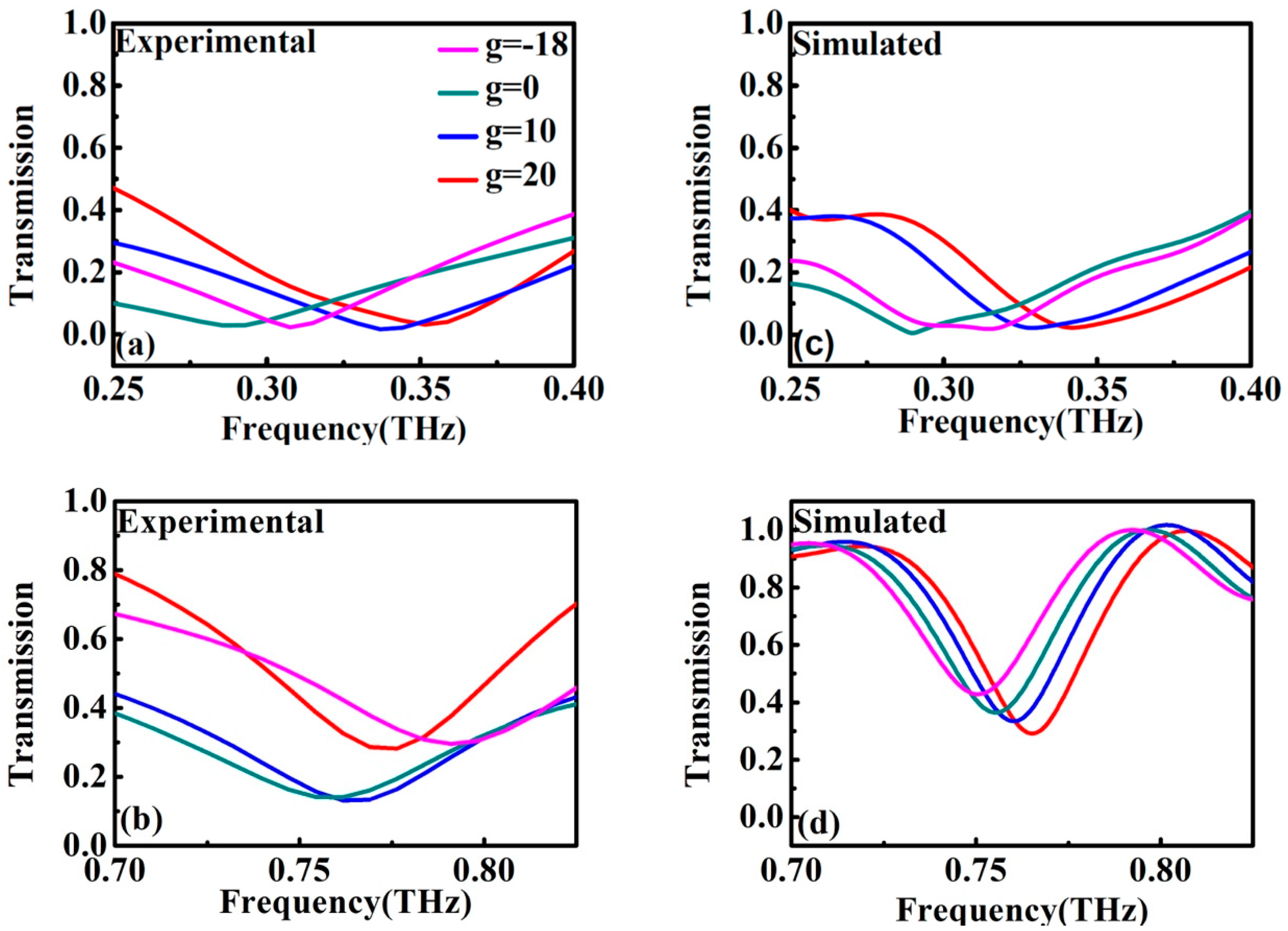
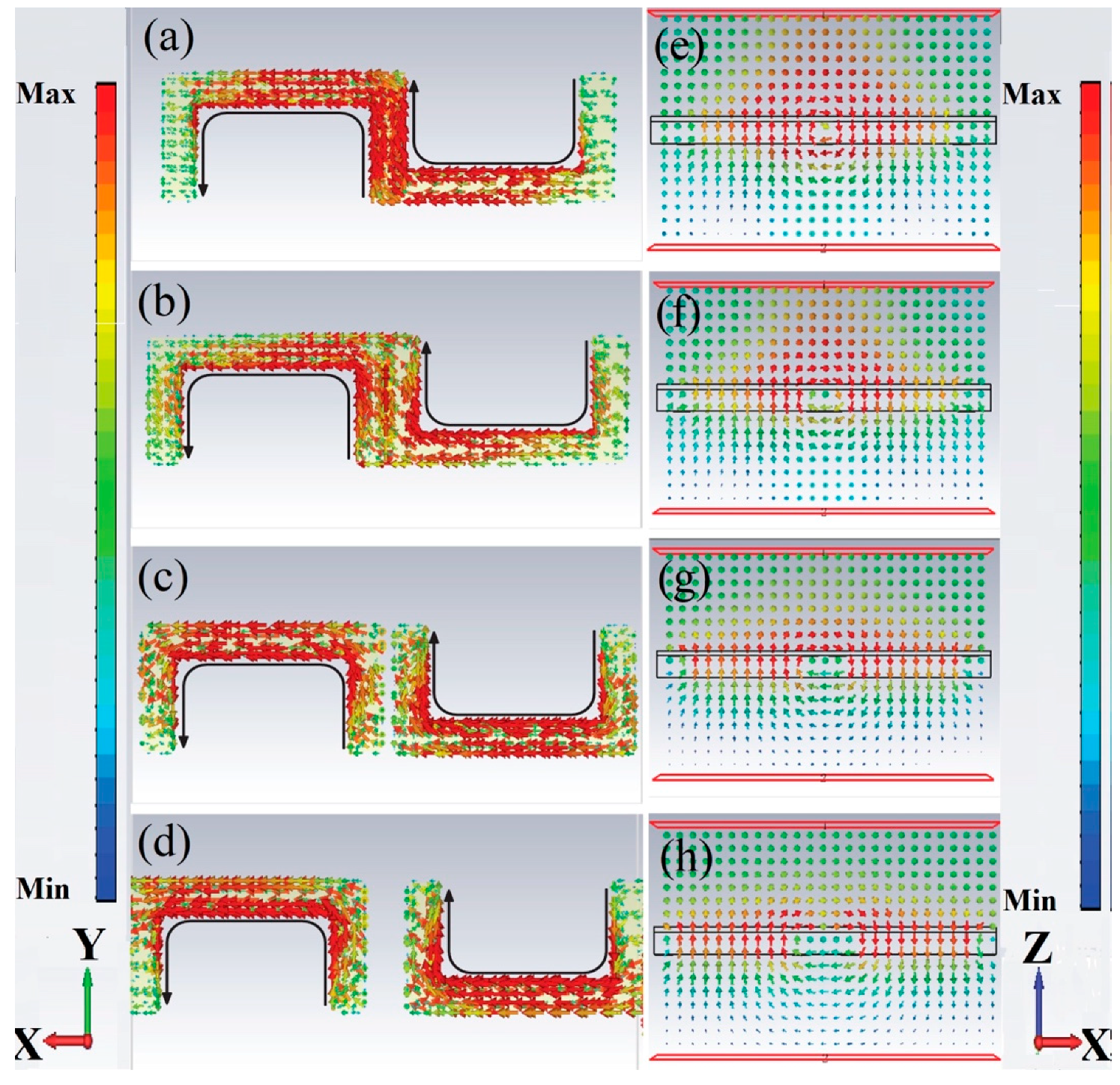
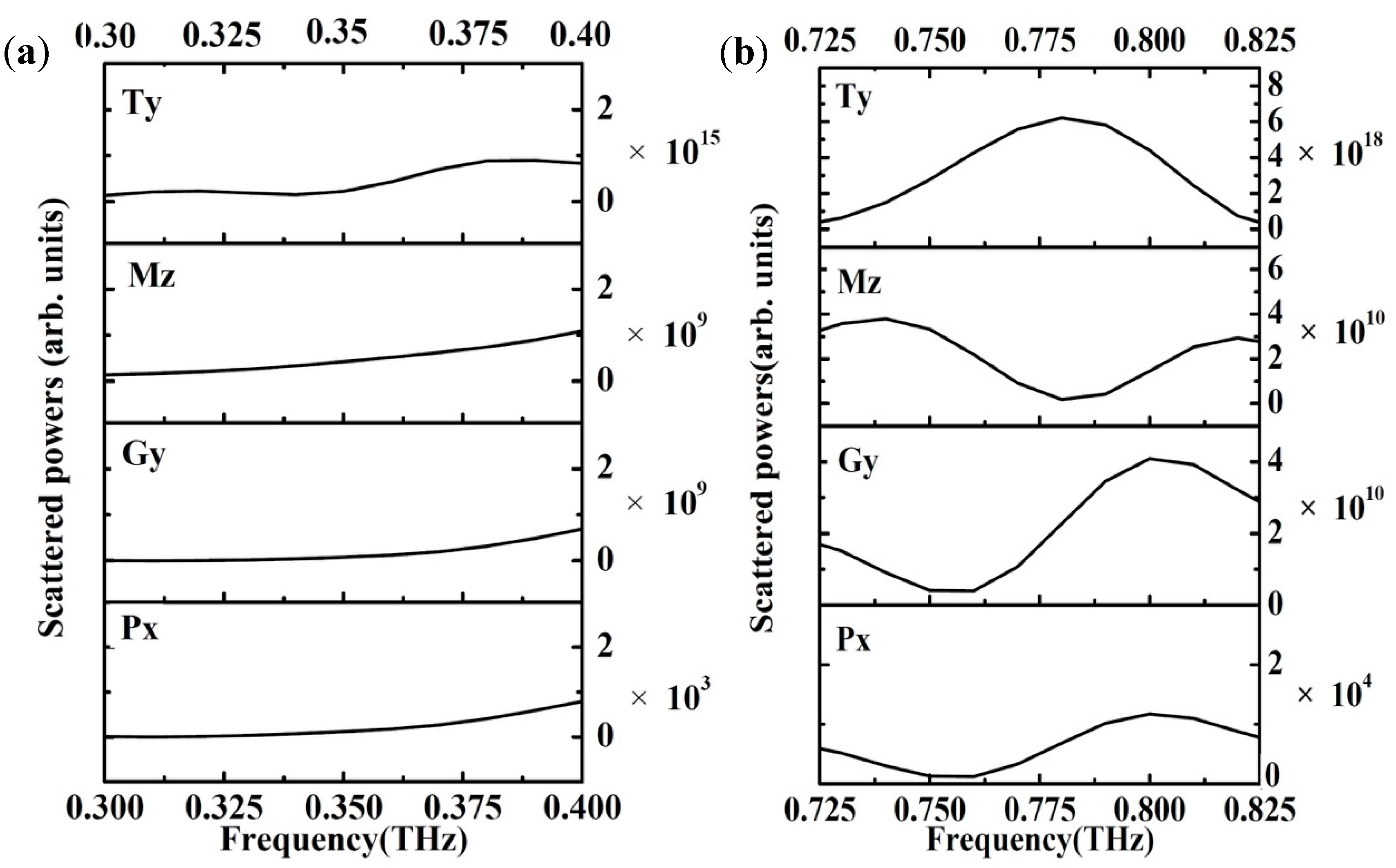

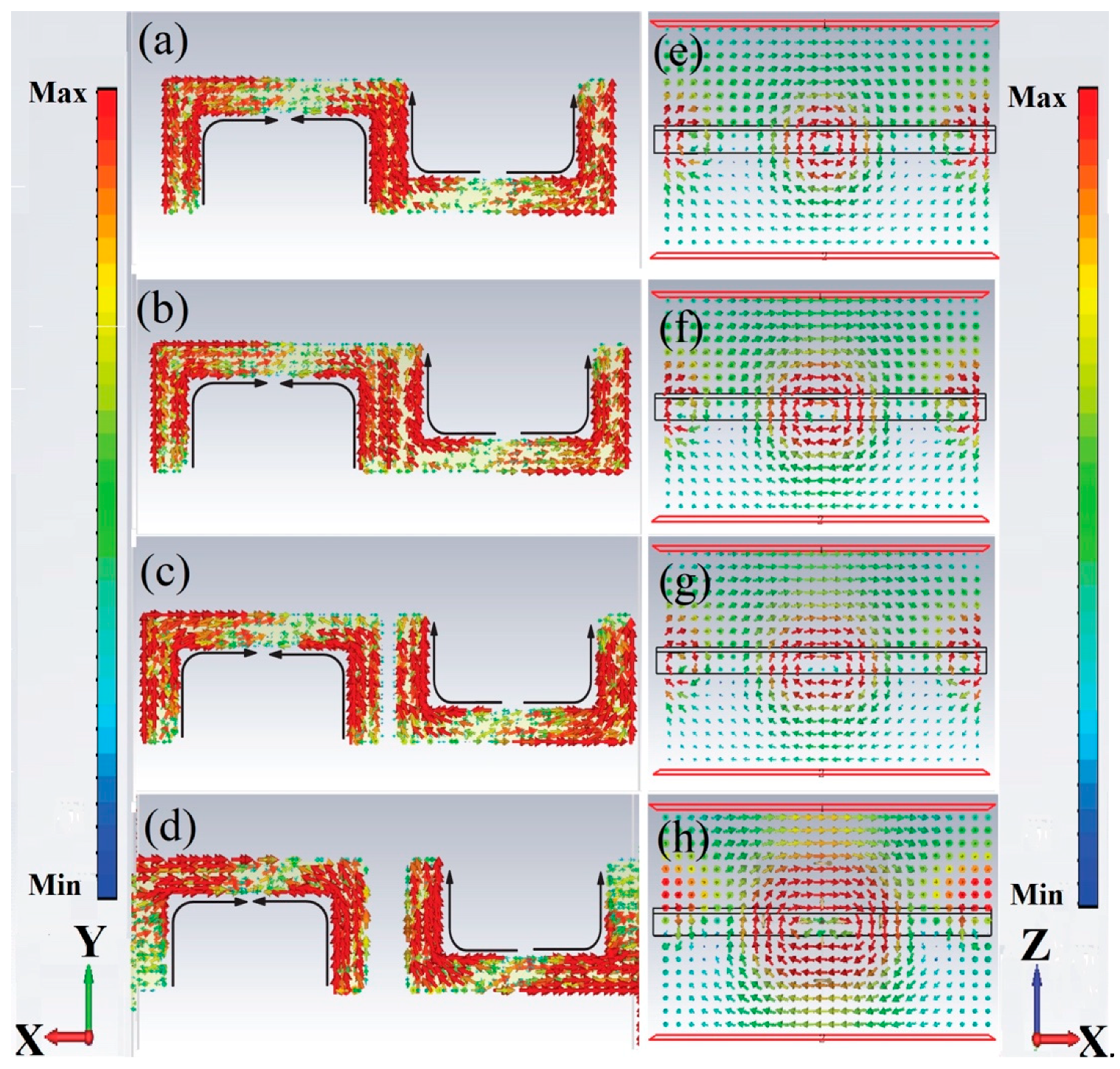
© 2018 by the authors. Licensee MDPI, Basel, Switzerland. This article is an open access article distributed under the terms and conditions of the Creative Commons Attribution (CC BY) license (http://creativecommons.org/licenses/by/4.0/).
Share and Cite
Wang, S.; Wang, S.; Li, Q.; Zhao, X.; Zhu, J. Dual Toroidal Dipole Resonance Metamaterials under a Terahertz Domain. Materials 2018, 11, 2036. https://doi.org/10.3390/ma11102036
Wang S, Wang S, Li Q, Zhao X, Zhu J. Dual Toroidal Dipole Resonance Metamaterials under a Terahertz Domain. Materials. 2018; 11(10):2036. https://doi.org/10.3390/ma11102036
Chicago/Turabian StyleWang, Shuang, Song Wang, Quan Li, Xiaoli Zhao, and Jianyu Zhu. 2018. "Dual Toroidal Dipole Resonance Metamaterials under a Terahertz Domain" Materials 11, no. 10: 2036. https://doi.org/10.3390/ma11102036
APA StyleWang, S., Wang, S., Li, Q., Zhao, X., & Zhu, J. (2018). Dual Toroidal Dipole Resonance Metamaterials under a Terahertz Domain. Materials, 11(10), 2036. https://doi.org/10.3390/ma11102036




